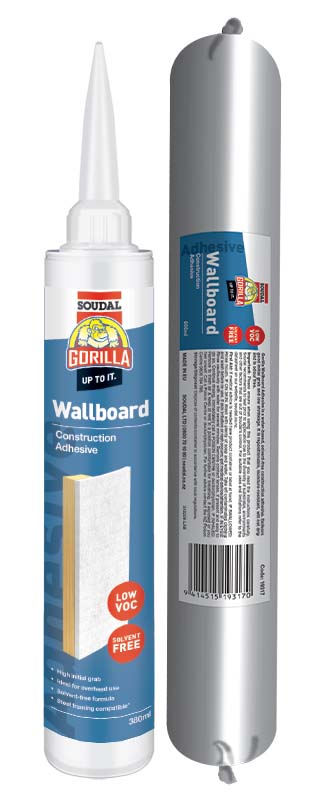Gorilla Wallboard Adhesive & Wallboard Popping
One of the biggest problems encountered when fixing wallboard is “Fastener Popping”. This is where the movement of either the timber and/or a reduction of moisture content in the timber causes the fastener heads to become visible through both the Gypsum Wallboard and the paint/wallpaper.
Types of Wallboard Adhesives
In the market there are several different adhesives for fixing Gypsum Wallboard to wooden or steel battens for walls and ceilings. These adhesives are based on two different types of formulation;
1. Those which use synthetic rubber resins and may have larger quantities of solvents in them – as much as 50-55%.
2. Those that are acrylic (water) based. Even acrylic adhesives can differ considerably in the amount of water they have. The higher the amount of water, the less solids you are left with, once the adhesive has cured. Some acrylic based adhesives have as much as 20-30% water.
This is important because – it is the “solids” part of any adhesive that does the work.
The Gorilla Wallboard Adhesive (GWBA) Solution:
Gorilla Wallboard Adhesive is a unique Acrylic Wallboard adhesive unlike most others. It has a very high solids content, is not solvent based and has only 5-8% water content.
In many construction situations today, the use of solvent based adhesives is not advisable or permitted. Some of these instances may include:
• Health centre facilities
• Educational buildings
• Government contracted construction projects
• Green Build construction sites
• A more informed end user (especially homeowners)
Causes of Fastening Popping
The advent of modern stick and “frame and truss” building techniques has brought about much more “Fastener Popping” as the nature and maturity of the timber used has decreased. Modern approaches have meant a much greater degree of twisting and bowing of the timber once in place and where moisture is an issue. While the “Frame and Trussing” plants produce product with timber moisture contents that meet the needs of the market, once the timber has been exposed to wet weather on-site, the framing timber may swell and twist, leading to dimensional changes. If interior wall linings are then applied, and the timber subsequently dries out and shrinks, and twists – force and strain is placed on the adhesive bond.
This strain on the adhesive may cause the gypsum wallboard paper backing to come free of the gypsum wallboard. This is called “Popping” (where the mechanical fastening is effectively pulled through the Gypsum Wallboard Lining).
How adhesive selection can affect Fastening Popping
Using adhesives with a high amount of evaporation, whether it be from solvent or water in the physical bond, combined with the twisting and drying out of the timber, tends to add a large amount of strain on the bond, heightening the risk of “Popping”.
We can’t control the twisting in the frame and trussing timber, but we can through the correct choice of adhesive, and observance of the “guide” (see note below) around moisture content ensure that we minimise the potential for “Popping” as much as possible.
This is where the Gorilla Wallboard Adhesive solution offers peace of mind to both the builder and the homeowner!
Gorilla Wallboard Adhesive has super high solid levels and super low moisture levels. While other wallboard adhesives actively add more moisture to the problem area, Gorilla Wallboard Adhesive adds only the smallest amount – thereby significantly reducing the risk of Fastening Popping.
NB: Observance of the Guide: Before completing the interior linings on a build there is a requirement for the timber to have a moisture content of less than 18%, however it should be noted that some companies that supply gypsum linings require a moisture content of 12% or less where central heating, heat pumps or air-conditioning is to be installed. When was the last time you saw a new build that didn’t have one of these?
Want to save this guide? Download the PDF version here

